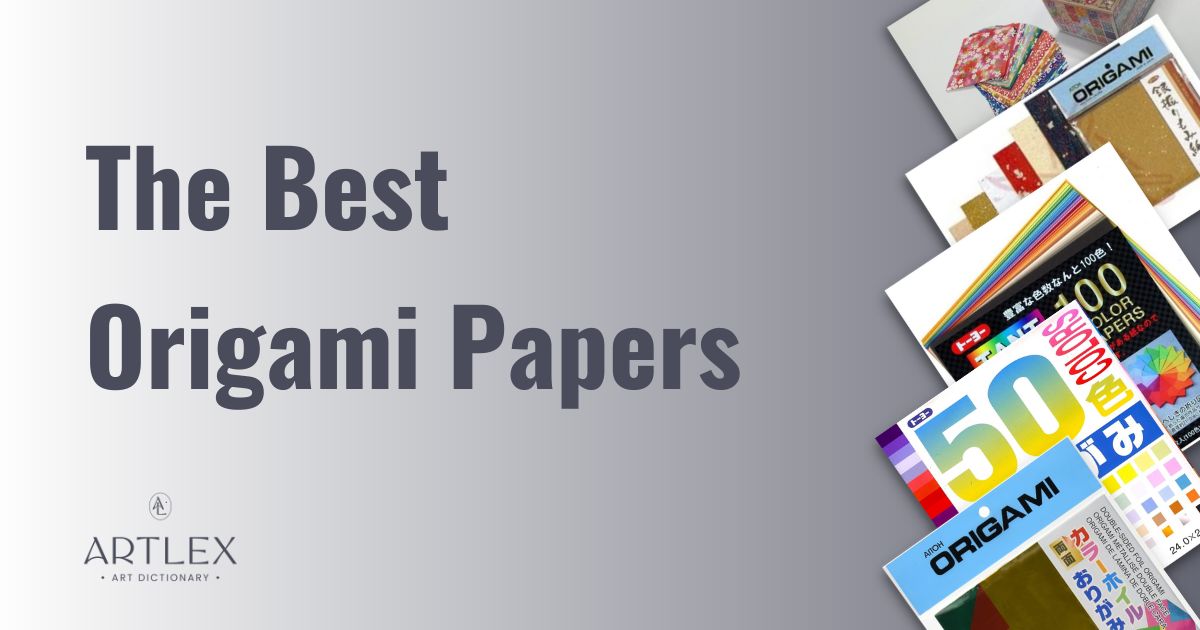
Origami is the traditional Japanese art of creating objects like animals, shapes, or figures simply by folding paper.
While technically origami can be practiced with any paper, there is special origami paper that is made for the job. The difference between origami paper and kraft paper or even regular printer paper is that it makes a strong fold line. The ability to hold creases and the beauty of the paper are the primary markers that separates origami paper from other papers.
Choosing the best origami paper can seem daunting, but keeping the following criteria in mind can help you buy the best origami paper for your needs – where it is made, the factory it is made from, the paper size and lastly, the price. More information on why we chose our criteria is below.
Types of Origami Papers
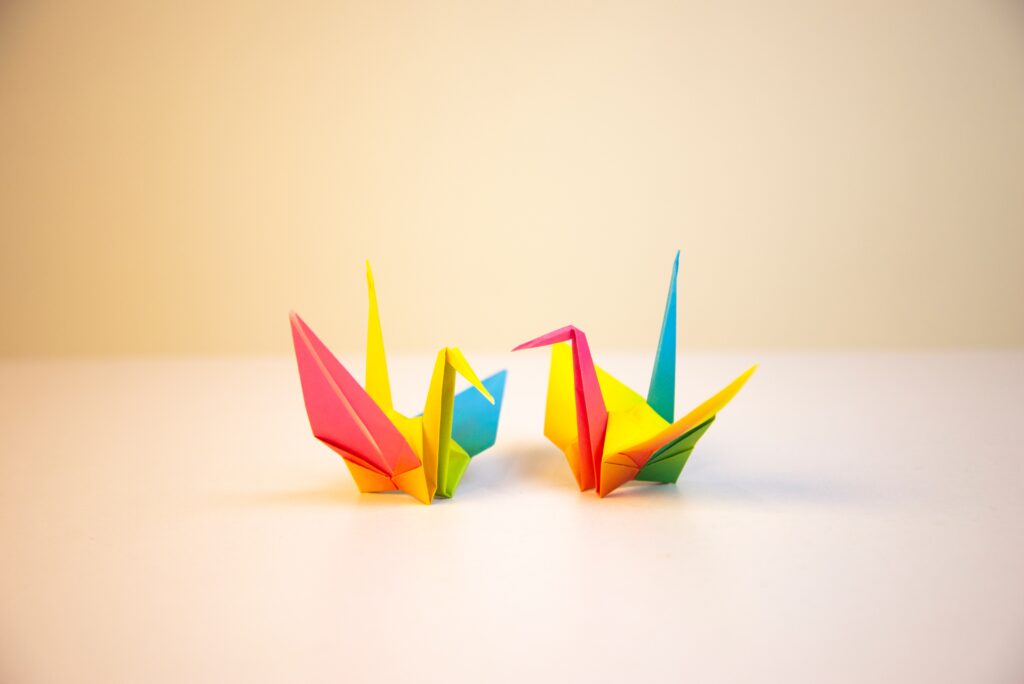
Making paper is said to have originated in China thousands of years ago and was brought to Japan by monks. Today, origami is common not just in Japan but also worldwide with kids and adults alike. Many famous origami artists have mastered the folding technique and can create complex models of origami figures, different shapes, and other complex models.
If you are just starting out, you might want to go for the Best Origami Kits for Beginners, instead of just paper.
There is a considerable variety of origami paper, from premium to standard paper. Japanese paper is the most high-quality paper since it is made with non-toxic inks that are applied directly to the fibers, creating a folding paper that creases nicely and does not crack once folded.
Below, we have outlined the most common types of papers and the best paper for different projects.
Kami Paper
Kami is the Japanese word for “paper,” and no wonder this is the traditional Japanese paper used to create origami art. This standard origami paper and is best for beginners just entering the world of origami for its price and how easily it holds creases. It can have the same color on both sides or come in two different shades.
Tant Paper
Origami artists prefer tant paper for its vibrant colors. It is also thicker than other origami papers, can hold creases well, and is the perfect paper to use to fold super complex models.
Washi Paper
Washi literally translates to “Japanese Paper.” It is one of the best origami papers for wet folding due to its thickness. Washi paper is thinner than tant paper, creases nicely, and is another standard origami paper made of plant fibers and is mainly used for complex models due to its long fibers.
Washi paper comes in solid colors with the same color on both sides, two different colors, or various Asian-inspired patterns. Be sure to look for different themes, like kimono, traditional Japanese art, cherry blossoms, bamboo, or other unique patterns. This paper is also one of the softer, more textured papers and is likened to fabric, bringing origami models to life in a way other papers can’t.
Lastly, this paper is dyed using two inking processes, making it one of the more expensive origami papers to buy.
Tissue Paper
Tissue foil paper is a combination of tissue paper and foil paper. Tissue foil is pretty thin, easy to fold, and holds creases very well. Foil makes super complex models easier to fold due to their thin and strong makeup.
Chiyogami Paper
Another high-quality origami paper, Chiyogami papers, are made using Kozo, Gampi, and Mitsumata fibers that produce a solid and tough paper. This handmade paper is silk-screened layer by layer onto the paper, usually using metallic prints.
FUN FACT: Origami means “to fold paper” in Japanese. This tradition is thousands of years old and is said to have originated in China.
Origami Projects
Origami projects boil down to two different folds, mountain fold and valley fold, and a wet fold technique. It’s essential to work on a hard, flat surface, so the paper is easy to fold. The more complex origami shapes will require larger paper, while smaller papers are suitable for fewer folds.
Mountain Fold
Mountain and Valley folds are the basis for creating origami art. Beginners must understand these two folds before moving on to other folding techniques.
- Fold the paper in half, making a solid crease
- Lift the paper slightly off of a flat surface with the crease upwards to create a mountain shape
- Both folds can be created in one paper by applying the first step then folding the outer in equal sizes to creates valley folds
Valley Fold
Valley and mountain folds are sometimes used together.
- Fold the paper in half, making a solid crease
- Lift the paper slightly off of a flat surface with the crease downwards to create a valley dip
Wet-Folding
Wet folding uses water to create curved shapes on paper. Wet folded paper allows models to appear softer and makes it easier to make curves.
- Best Overall Origami Paper: Showagrimm Set of 30 Designs Origami Washi Paper
- Best Traditional Origami Paper: Toyo 50 Colors 9.4-inch Kami Origami Paper
- Best Tissue Foil Origami Paper: Aitoh DSF-2 Double-Sided Tissue Foil Origami Paper
- Best Tant Origami Paper: Toyo Tant 100 Colors Origami Paper
- Best Washi Origami Paper: Aitoh Ginburi Momigami Washi Origami Paper
1. Best Overall Origami Paper – Showagrimm Washi Origami Paper
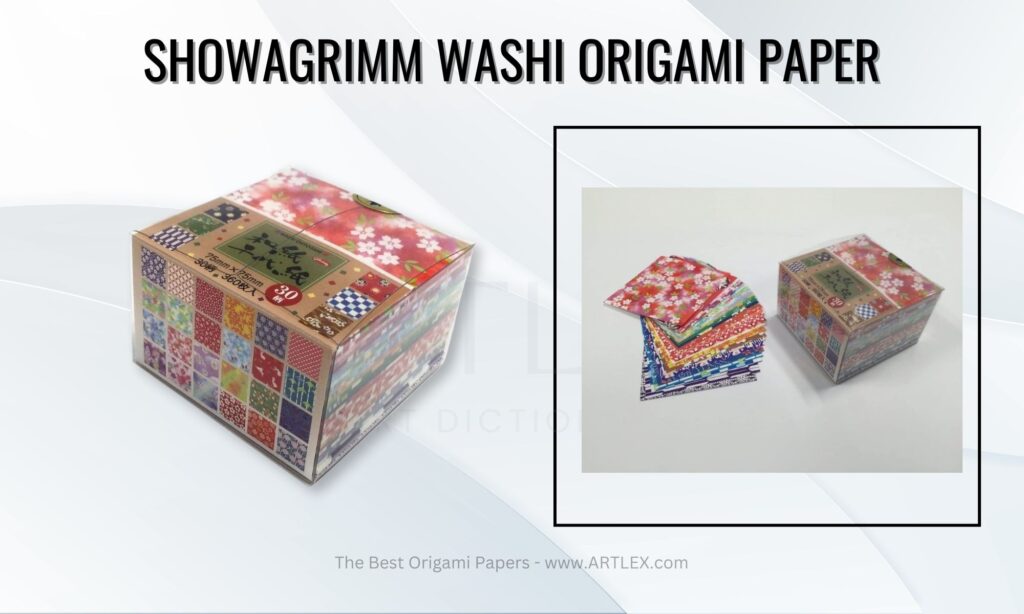
Selection Criteria
- Price – ~$9 – Our score: 9/10
- Made in Japan – Yes – Our score: 10/10
- Factory Made – Yes – Our score: 9/10
- Origami Paper Size – 3×3 inches – Our score: 9/10
Showagrimm Washi Origami Paper
This standard origami paper comes with 360 sheets of a variety of patterns that make any origami model look unique and exciting. The patterns are on one side of the paper, with the other side being completely white. These papers are thin enough to crease nicely and are especially useful to create origami cranes.
These are the best papers due to the 30 different designs, the paper’s thickness, and the duo-sided pattern that allows beginners to experiment with various techniques.
Pros
- Thicker than most other origami papers and can be used with the wet-fold technique
- Has gorgeous traditional patterns
- Includes a large variety of paper
- Bright and vibrant patterns
Cons
- Can be more textured
FUN FACT: Astronauts created a flower-shaped shade to block out the sun. While not called origami, they used similar paper folding techniques practiced in this art form.
2. Best Traditional Origami Paper – Toyo 50 Colors Kami Origami Paper
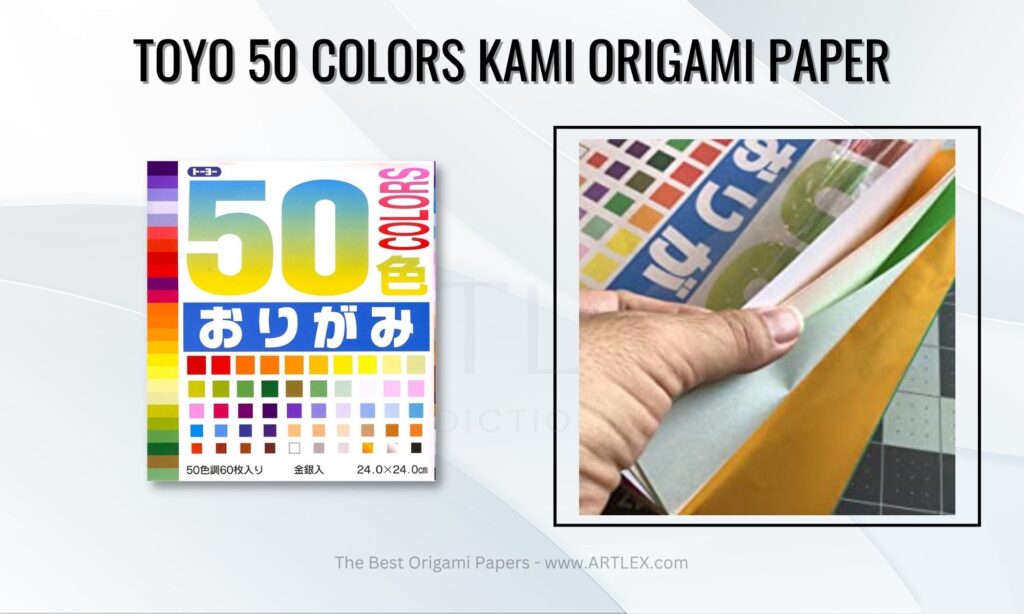
Selection Criteria
- Price – ~$8
- Our score: 8/10
- Made in Japan – Yes
- Our score: 10/10
- Factory Made – Yes
- Our score: 9/10
- Origami Paper Size – 9.4-inches
- Our score: 8/10
About Toyo 50 Colors Kami Origami Paper
This Kami standard origami paper is large for beginners learning intermediate-level models, holds creases well, and is the perfect paper to fold animals, flowers, and other larger models. One side of the paper has a solid color, while the other is white. This paper holds creases well, and while it isn’t strong enough to create models that require many creases, it is an excellent introduction to origami for beginners.
The larger-sized paper is one of the easiest papers to learn more difficult models on and can greatly reduce frustration.
Pros
- Excellent variety of colors
- Creases very well
- Easier to learn more difficult models
Cons
- Isn’t strong enough for many folds
3. Best Tissue Origami Paper – Aitoh DSF-2 Double-Sided Origami Paper
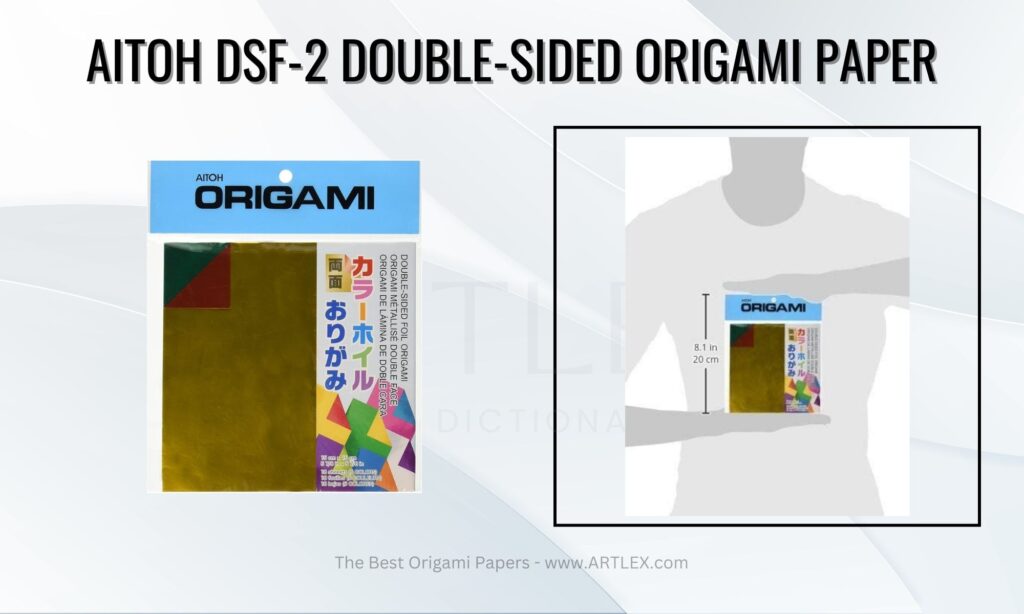
Selection Criteria
- Price – ~$7.28
- Our score: 8/10
- Made in Japan – Yes
- Our score: 10/10
- Factory Made – Yes
- Our score: 8/10
- Origami Paper Size – 5.9×5.9-inches
- Our score: 8/10
About Aitoh DSF-2 Double-Sided Origami Paper
This type of origami paper has tissue paper on one side and foil paper on the other. The paper has two different colors on each side, includes 18 sheets, and works well for various complex origami projects. It can also be used to fold shapes like cranes, flowers, or animals for Christmas due to its shiny surface. This thin paper tears easily when wet and is not recommended for wet folding.
Due to its price, this paper is not suggested for beginners. In addition, as this paper is a bit thick, it can be helpful to use a pencil to help create a better finer crease.
Pros
- Beautiful shiny surface
- Holds curves well without using a wet folding technique
Cons
- Is more expensive than other origami paper
4. Best Tant Origami Paper – Toyo Tant 100 Colors Origami Paper
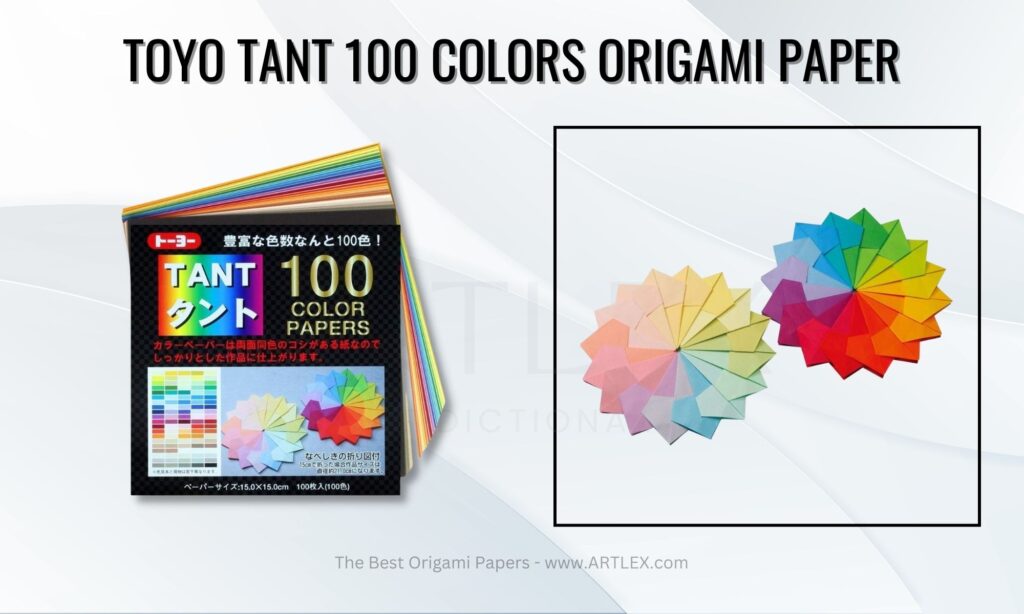
Selection Criteria
- Price – ~$7 (Was $8)
- Our score: 8/10
- Made in Japan – Yes
- Our score: 10/10
- Factory Made – Yes
- Our score: 9/10
- Origami Paper Size – 5.9×5.9-inches
- Our score: 9/10
About Toyo Tant 100 Colors Origami Paper
This tant paper has a thickness that makes it excellent for creating simple folds, while the texture makes it perfect for modular origami and to create buildable and intricate models. Each paper has the same color on both sides, and the thickness makes folding the paper and holding a crease rather easy.
This pack of Toyo tant paper comes with 100 different colors.
Pros
- Gorgeous variety of vibrant and bold colors
- Has a matte paper finish
Cons
- Both sides are the same color
5. Best Washi Origami Paper for – Aitoh Washi Origami Paper
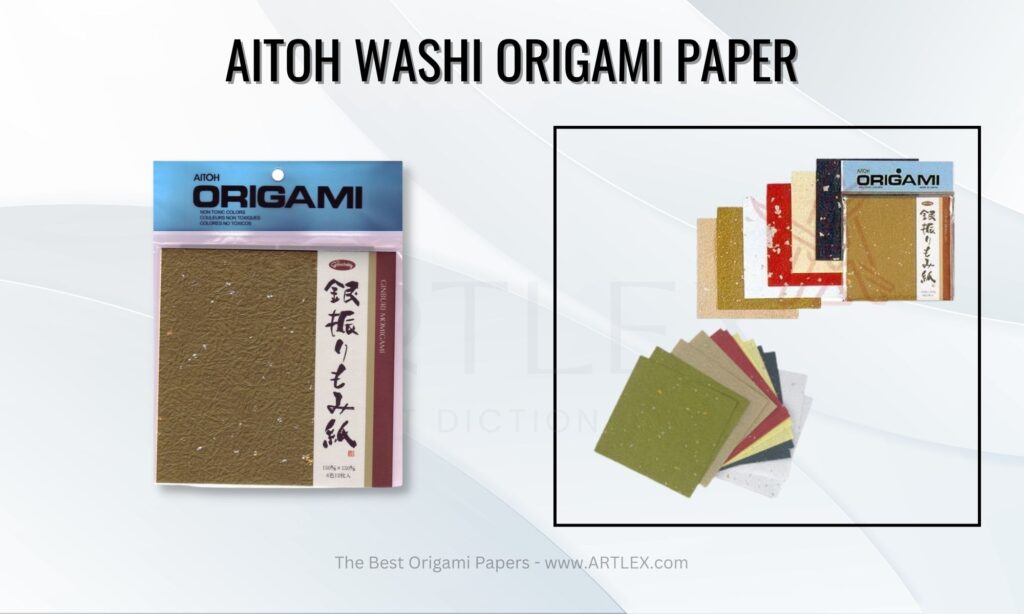
Selection Criteria
- Price – ~$14.85
- Our score: 8/10
- Made in Japan – Yes
- Our score: 10/10
- Factory Made – Handmade
- Our score: 9/10
- Origami Paper Size – 6×6-inches
- Our score: 9/10
About Aitoh Washi Origami Paper
Aitoh has made this gorgeous handmade origami papers that are thin enough to create complex models, while still being strong to maintain their shape. Perfect for gift giving, this set comes with 12 sheets of paper with two colors each that are made out of plant fibers. Some sheets even have metallic fibers intertwined for a more interesting affect and colorful shine.
This paper is not suggested for wet folding techniques.
Pros
- Handmade so each paper is different
- Is created with metallic fibers
Cons
- May be expensive for some artists
Conclusion
This wraps up our guide to the best origami paper. Not only have we discussed how you could identify different kinds of origami paper, but we’ve also shared our recommendations in various contexts.
We’ve discussed how you can choose the best origami paper and why these key deciding factors are important, including country and specific factory, as well as price and size. We’ve outlined them thoroughly to help you understand them easily.
Lastly, we’ve combined our recommendations in different situations. So whether buying the best origami paper for beginners, for complex models, or standard origami paper, we’ve discussed it all.
Thanks for reading; we hope our suggestion helps you purchase the best origami papers for your next project.
Sources
- https://en.wikipedia.org/wiki/Origami_paper
- https://www.britannica.com/art/origami/History-of-origami
- https://www.tarosorigami.com/buying-guide-for-paper-for-origami/
- https://exoplanets.nasa.gov/resources/1015/flower-power-nasa-reveals-spring-starshade-animation/
- https://www.mulberrypaperandmore.com/c-194-chiyogami-yuzen-paper.aspx



